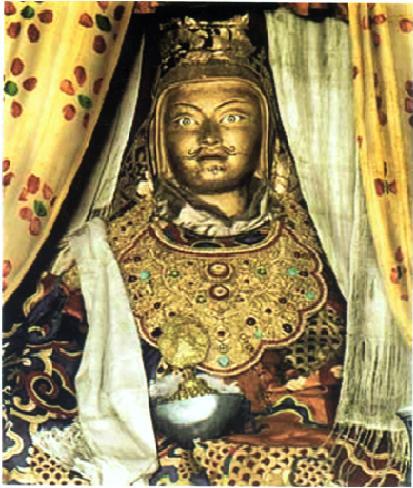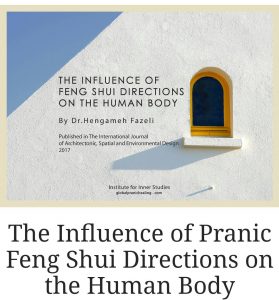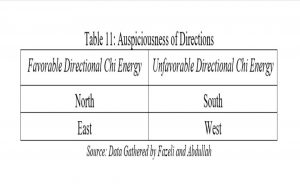Pranic Feng Shui – Influence of Feng Shui on the Human System
There are various principles and patterns that have been established in traditional societies. These patterns have been established based on experiences of generations dealing with the environment and how it affects the well-being of the users. It is believed in Feng Shui that architecture has a direct influence on the physical and psychological health of the users due to its effect on the energy field surrounding the body.
Feng Shui, which literally translates to wind-water, is the intuitive ancient art of understanding the energy of elements and directions. Although the existence of this energy field is scientifically proven, it is not widely discussed in the field of architecture. Therefore, the application and effectiveness of Feng Shui guidelines remains debatable. A study was conducted to validates the guidelines relating to the auspiciousness of the four main directions of Feng Shui where the size of the energy field surrounding the body was measured using AcuGraph and Pranic Scanning. It is hoped that the findings from this study will enhance the knowledge in the discipline of architecture.
Conclusion and Findings The result of experiments on forty participants with various cultures, backgrounds, and religion shows that directions impact the size of the aura, the activation level of the chakras, and energy meridians. That is the reason why certain directions were considered auspicious while others not.
Based on the results of the AcuGraph experiments and Pranic Scanning, it is observed that the north direction increases the size of the aura but does not necessarily balance the chakras. Therefore, the effect of the north direction is activating. Based on Pranic Healing teachings, more energy equals to better health and activeness (Anpalagan 2009). Therefore the northern direction is considered auspicious in Pranic Feng Shui and Vastu Shastra. The authors believe that the activating effect of the north direction has led it to be associated with prosperity and abundance in Pranic Feng Shui (Gorgonia 2008). In Vastu Shastra the Lord of the North is Lord Kubera, the god of wealth (Krishna 2001).
The east direction increases the size of the aura to some extent. It also balances the chakras and the energy level in the twelve sets of meridians. Therefore, the effect of the east direction is cleansing and strengthening. Pranic Feng Shui believes that congestion or depletion of energy is lack of balance and can lead to disharmony and disease (Gorgonia 2008). The balancing effect of the east direction therefore, makes it an auspicious direction as well. That is why the east direction is auspicious in both Feng Shui and Vastu Shastra. It has always been considered a holy direction in traditional societies (Oliver 1997), and it is often associated with meditation, healing and spirituality. The Lord of the East, is known as Lord Indra, who is related to festivity and power (Krishna 2001). The west direction decreases the size of the aura but balances the chakras. Therefore, the effect of the west direction is cleansing and purification. However, it creates weakening effects on the aura. In Pranic Healing, the West direction is for healing. However, because of its purifying effect, it creates depletion.
The colour of energy coming from the West direction, according to Master Choa Kok Sui, is Green prana. Green prana in Pranic Healing is used for cleansing and purifying the aura, but if it is used for a long period of time, it causes depletion and weakness (Anpalagan, 2016). The authors believe that its depleting effect on the aura makes the west direction inauspicious, despite its cleansing effects. The Lord of the West in Vastu Shastra is Lord Varuna who is in charge of rain, which is connected to healing and purification (Kumar 2005).
The south direction decreases the size of the aura and causes imbalance. The effect of the south direction is thus, depleting. In Pranic Feng Shui, the South direction is the most inauspicious direction among the main 4 directions. The reason should be the deeper cleansing and depleting effects it creates on the aura. According to Anpalagan, the South direction in Pranic Feng Shui is very deleting and can severely affect the health of the body. When the aura becomes depleted, the physical body becomes weak and immunity gets lower therefore it becomes susceptible to disease (Wong, 2016). This might be one of the reasons why this direction has been associated with poverty in Pranic Feng Shui (Gorgonia 2008).
In Vastu Shastra, the south direction is considered the direction of death or weakness. Lord Yama, who is the Lord of Death, is the connected to the south direction in Vastu Shastra (Kumar 2005). Directions that increase the size of the aura are considered auspicious since, based on complementary sciences such as Pranic Healing, more Prana or energy is equivalent to improved health. Energy or Prana is the what keeps the body healthy and alive. According to Pranic Healing, just as how light affects chemical reactions, Prana increases the chemical reactions in the body, thereby helping the physical body to heal faster (Master Choa Kok Sui 2006). Prana is the energy that keeps the body healthy and alive. Based on our observations and experiments, people with bigger energy body, tend to have a better physical and psychological health†(Anpalagan 2016).
The results of AcuGraph and Pranic Scanning further show that the influences of directions on the aura are independent from personal preferences. Having a previous knowledge regarding Feng Shui or believing in the auspiciousness of a certain direction did not create a great difference in the results of the AcuGraph and Pranic Scanning experiments. Although the researchers were expecting to observe a greater impact on participants who had prior knowledge of Feng Shui and preconceived ideas of various directions, the results did not show much difference. Therefore, as Alexander (1979), Day (2004), and Salingaros (1995) have suggested in their studies, the impact of architectural forms, colors and directions are objective and affect the users regardless of their beliefs and preferences. Based on the result of the studies, the author believes the south direction depletes the lower chakras more than the upper chakras, while the north direction activates the lower chakras more than the upper chakras.
The east direction, on the other hand, activates the upper chakras and balances the aura. Therefore, this proves that the auspiciousness of directions according to Pranic Feng Shui is correct. The summary is shown in Table 11.
The findings discussed in this research have both academic and practical significance. In academic perspective, it helps to solve the controversies that exist among Feng Shui Masters and scholars in determining the exact guidelines and principles of Feng Shui dealing with directions, and help introducing Feng Shui as a science rather than superstitions. Guidelines of Feng Shui are currently treated as spiritual and ritualistic views towards architecture without explaining and introducing their practical and tangible impacts on physical and psychological conditions of the users. This gap in the knowledge of traditional geomancy and the significance of their proposed guidelines can be filled through this research. Professionally, this study is significant for architects as well as the public to find out the other important factors of design. This, along with the physical standards, could improve the quality of living in housing areas and office spaces. The effective use of these factors would encourage architects to build places that promote health and well-being of the users



